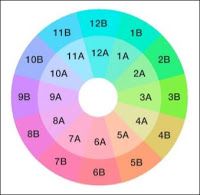The Board affirmed a refusal to register the design mark shown below, finding that the design is a graphic tool used by DJs to discern harmonic compatability, and does not function as a trademark for "Computer software for music analysis and processing; computer software for manipulating, mixing, and performing music and sounds" and for "Providing advice and information in the field of DJ'ing methodology and the analysis, selection and arrangement of music and sound recordings." In re Mixed in Key LLC, Serial No. 87789666 (August 27, 2019) [not precedential] (Opinion by Judge Jonathan Hudis).

The critical question in failure-to-function cases is whether the proposed mark would be perceived as a source indicator for the involved goods or services. To make this determination, the Board looks to the specimens of record and other evidence to discern how the proposed mark is actually used in the marketplace.
From industry publications made or record by Examining Attorney Ahsen Khan, the Board concluded that the design mark at issue is a "stripped down version of the Camelot Wheel, which in turn is a reinterpretation of the Circle of Fifths." Applicant's software "processes and analyzes music with respect to musical key, energy, and cue points so that DJs may manipulate, mix and perform music and sounds in an optimal manner."

The Circle of Fifths is a graphic device that illustrates the relationship among the 12 tones of the chromatic scale, their corresponding key signatures, and the associated major and minor keys. The Camelot Wheel, which is numbered like a clock, is a variation of the Circle of Fifths and is used by DJs to select songs that are in compatible keys by using adjacent and relative major/minor keys. Applicant's Mixed-in-Key software analyzes a DJ's music files and labels them as to key. The "wheel" then indicates which keys are compatible so that the songs the DJ plays appear to "sing" together.
Applicant argued that its design is not used in the operation of the software; instead the results are displayed in row and column format. The image of the design appears at the top of the computer screen during use, and it also dominates Applicant's website, because it is set off from surrounding text and other graphic material.

The Board, however, agreed with the Examining Attorney that the prominent placement of the design on the software is not likely to cause Applicant's customers to perceive the chart as a source indicator for Applicant's services. And, as the Examining Attorney asserted, "its prominent placement is a direct result of the need to refer to the chart when mixing tracks in order to understand the relationship between the various tracks as depicted in the chart." (emphasis in original).
We conclude that the design does not serve as an indicator of source for the goods set forth in the application. Our conclusion is supported by Mr. Vorobyev's statements regarding how the MIXED IN KEY software operates and in the DJ industry articles provided by the Examining Attorney. Without a DJ's reference to Applicant's Applied-For Design, the music track "Key Result" data column provided during the operation of Applicant's software would be meaningless to a DJ using the software for Harmonic Mixing or Energy Boost Mixing – unless the DJ was to memorize the alpha-numeric designations and their relationships within Applicant's Applied-For Design.
As to Applicant's advice or information services, "Applicant's mere prominent inclusion of Applicant's Applied-For Design next to a brief explanation of Applicant's advice and information services, without more, does not turn a graphical tool for DJ techniques into a mark indicating the source of Applicant's services."
And so the Board affirmed the failure-to-function refusal.
The content of this article is intended to provide a general guide to the subject matter. Specialist advice should be sought about your specific circumstances.
